Eyeglasses
History of Eyeglasses
Eyeglasses have actually been around a lot longer than I originally thought but they have not been so widely used as they are now. Most of the time if you had a problem with your eyes you were farsighted and needed help with things that were close up. These things usually develop in older age. There are two main conditions that require glasses: Presbyopia (farsightedness) and myopia (nearsightedness).
In olden times, nearsightedness was not a common problem so when we talk about glasses for the most part we will be talking about reading glasses. Though this does beg the question: Why wasn't nearsightedness a problem like it is today?
We spend more time indoors and do more work close up. Close up work in less light causes eye muscles to contract over time effecting the shape of the eye. I found some surprising research in a May 2018 issue of Psychology Today which noted that children who live in societies who spend more time outside have lower instances of myopia than children who live in societies who spend more time indoors. Other research of the Inuit people found that those who stuck to a traditional lifestyle had fewer vision problems than those who chose to move into a more modern lifestyle.
There is also the idea that now that we don’t rely on our vision for hunting and gathering, and we aren’t dying off because we can’t see threats like a snake or bear or hole in the ground, maybe that is why vision impairments are becoming more prevalent. There is also this idea that glasses cause people to perceive you as intelligent and, as we will see as we go on, wealthy because not everyone could read or afford glasses— Glasses historically made you a more desirable partner.
As I said, we were mostly trying to fix weakening eyes due to old age so the first solution to this problem was a reading stone. This would be a polished piece of crystal or glass which was placed on the paper and moved over the text. The convex shape focuses light to enlarge the print.

An example of the functionality of a reading stone
Ziko van Dijk, CC BY-SA 4.0
Pliny the elder published his book Naturalis Historia in 77 AD and mentions an emerald reading stone used by emperor Nero.
We discovered a lens that dated around the 8th century in the Assyrian palace of Nimrud (modern day Iraq) but it is unclear whether this lens was used for a magnifying glass, a tool for lighting fires, or maybe just for decorative purposes.

The lens discovered in Nimrud, on display at the British Museum
Geni, CC BY-SA 4.0
It’s not exactly clear when the first spectacles were invented but we know they came out of Italy sometime around 1290 because of a sermon delivered in the 1300’s, the writing from which stated, “it is not yet 20 years since there was found the art of making eyeglasses which make for good vision.” We also see eyeglasses being pictured in renaissance paintings.

Portrait of Hugh of Saint-Cher, 1352
Risorto Celebrano, CC BY-SA 3.0
However, the use of eyeglasses was still rare and usually were among monks. Glasses were used for reading and very few people could read. The invention of the printing press in 1440 did increase the literacy rate, giving the glasses a larger audience. The first specialist spectacle shop opened in Strasbourg, France in 1466.
Before this point, lenses were all convex lenses for reading but the first known use of concave lenses for nearsightedness was for Pope Leo X in the 16th century. He was extremely nearsighted and he liked to hunt. Something had to be done for him.
It’s also important to mention that these spectacles were set in frames made of wood, metal, or even animal bone and for the most part had to be raised and held to the face by the user. Some did have ribbon to tie to the face or pinched to the bridge of the nose. In 1727, English obstetrician and instrument maker, Edward Scarlet first invented an eyeglass frame with ear hooks that looked very similar to the modern arms on our glasses today.
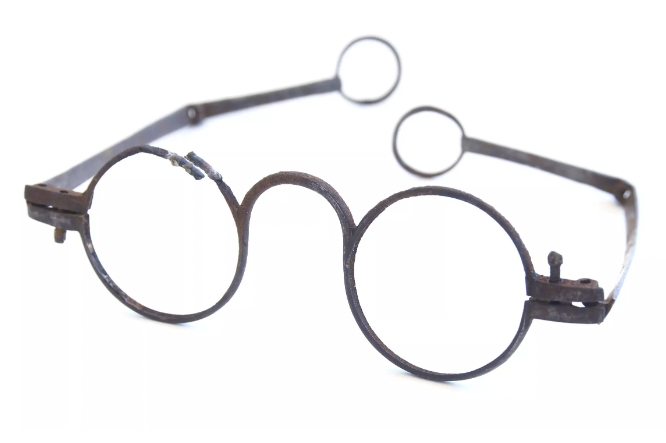
A pair of Edward Scarlet's glasses c. 1688
Then bifocals were invented in the 1760’s by Benjamin Franklin as he suffered farsightedness and nearsightedness. There are some who claim bifocals predate Benny but most everyone agreed to credit him with their creation. He cut two different lenses and put them together in one frame. The term bifocals actually didn’t get coined until 1827 when trifocal lenses were invented by john Isaac Hawkins with frames for distant, intermediate, and near sight.
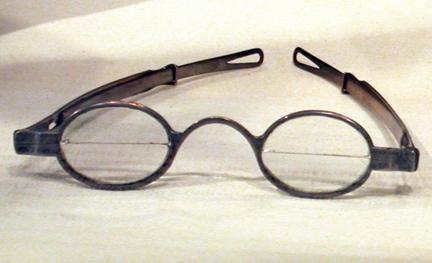
An early pair of bifocals
The next big invention was by Sir George Biddell Airy in 1825. He invented a lens that corrected astigmatism (irregular curvature of the cornea that can cause blurred vision at any distance).
In the early 20th century optician Moritz von Rohr invented the Zeiss Punktal lenses which made it possible for the wearer to see clearly when looking in their peripheral vision. Prior to this people had to turn their heads so the objects they wanted to see were at the center of the lens. This was the final step in glasses being what we know today.
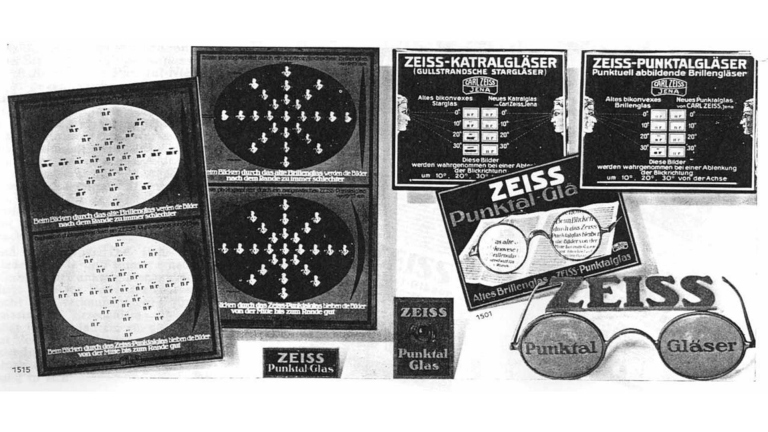
A display for Punktal glasses
ZEISS Group
First Contact
In 1888 we see the first “contact lens” invented by German ophthalmologist Adolf Fick. It was technically the first practical contact lens but the heavy blown-glass lens could only be worn for a few hours and covered the whole eye.

Early contact lenses
Kevin Tuohy in 1948 patented a lens that only covered the cornea and was made of acrylic glass. Supposedly they were comfortable enough to wear up 16 hours a day, which is way longer than I wear my modern contacts.
A Smooth Transition
Before we transition to sunglasses, we must first transition to sunglasses. That is to say, we’re going to talk about transition lenses aka. photochromic lenses.
In 1940 a research team at a subsidiary of what was then called Pittsburgh Plate Glass company or PPG developed CR-39 monomer. This material was used during WWII to line the fuel tanks of military bombers to protect them from bullet impacts. When the war was over they were left with a pretty substantial quantity of CR-39. So PPG asked its chemists to explore other uses for the product. By the mid 1950’s this led to lens makers using the monomer to produce eyeglass lenses.
In the 1960’s Corning Inc. became the first company to develop photochromic eyeglass lenses which were marketed under the PhotoGray brand.

An advertisement for Corning's PhotoGray glasses, 1992
In 1973 PPG began experimenting with applying photochromic technology to CR-39. Then in the 1980’s they discovered a new family of photochromics, the blue Pyridobenzoxazine. They eventually succeeded in 1988 and a year later the lenses were test-marketed under the Transition trademark. They partnered with Essilor, a European ophthalmic company.
PPG and Essilor moved forward with Transition Optical Inc. with 51% owned by PPG and 49% owned by Essilor. People increasingly began choosing the plastic lenses over the glass because they were lighter and more comfortable.
This is a really simple explanation of how transition lenses work: Silver halide crystals were added to molten glass and would cause the finished material to darken in reaction to UV light in just a few minutes. It would achieve maximum darkness after about 15 minutes. These early lenses didn’t always perform ideally because if your prescription called for one of your lenses to be thicker than the other, the thicker lens would darken more quickly and would be darker than the thinner lens after they were finished transitioning. However, in the 45 years since the first photochromic lens was introduced advances in lens material and manufacturing have significantly improved. Photochromics are now available in prescription and non-prescription eyewear such as goggles and even face shields for motorcycle helmets.
There are four different manufacturing processes but they were really long and really boring so I left them out but if you want to know you can read page 3 of this paper which briefly describes the photochromic manufacturing processes.
Sunglasses
The Inuits were the first to at least cover their eyes with the intention of protecting them from the sun and the way they did this was with a piece of walrus ivory carved into a loosely eye shaped design with slits for peering through (Just enough to see but without the glare) that were tied to the face with straps of leather. They could be made of bone or caribou antler or wood as well. A more accurate word for these would be sun goggles. If you’ve ever been in a very snowy region you know how badly they needed this because of snow blindness.
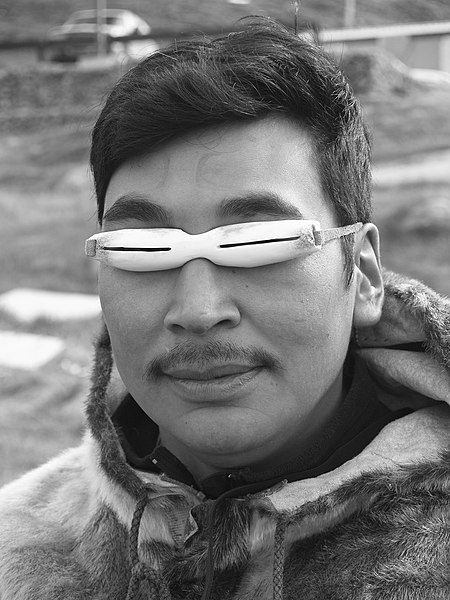
Inuit snow goggles made from caribou antler
Julian Idrobo, CC BY-SA 2.0
The inventors of sun glasses with lenses like we know today was of course from the Chinese. In the 12th century they used smokey quartz for the lenses but they didn’t use them necessarily for sun protection. They were for the judges in their court system to help them hide their emotions. They wanted to seem impartial and expressionless in the court room.
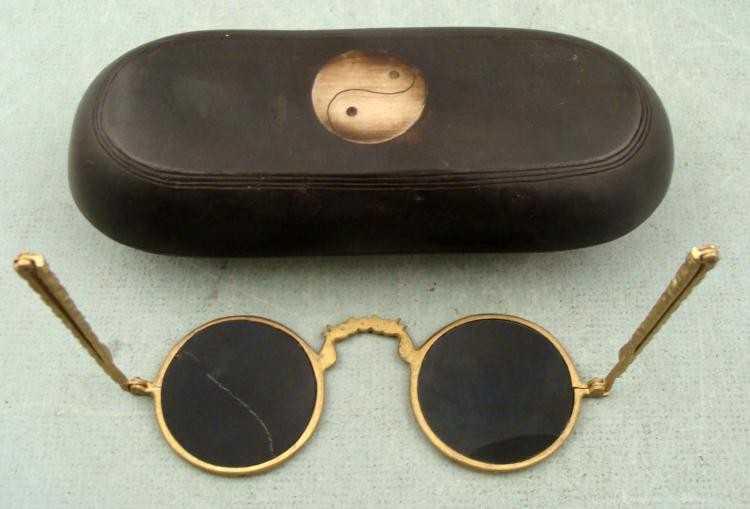
Ancient chinese sunglasses
Pliny the Elder wrote in his Natural History that Roman Emperor Nero would watch the gladiator fights through polished gemstones to reduce the glare from the sun. It was claimed that they were made of emerald but the ancient Romans were not able to precisely distinguish some minerals so they generally called beautiful green stones emeralds and the same with red being rubies, and blue being sapphires. But I think we did all agree that they were made with polished green lenses.
Around 1752 James Ayscough, an English optician began experimenting with tinted spectacles. He believed that green and blue lenses would help with some vision impairments. It’s not clear whether he was trying to help colorblind people— Green lenses create high contrast but I didn’t find anything claiming he was trying to invent colorblind corrective lenses.
In the 1800’s a different demographic of people discovered sunglasses: people with syphilis. In part this was due to the disease causing light sensitivity but it’s also because there were some sunglasses specifically made for them that had a metal nose piece between the frame that hid the rotting nostril tissue that the disease could cause. This did hurt the whole sunglasses image. For a brief time they were associated with STI’s and a sinful life style but that quickly changed in the 20th century when we start seeing movie stars wearing them to protect their eyes from the bright studio lights and flashing cameras. It also helps that penicillin was invented and those poor people suffering with syphilis actually had a cure. Once popular icons got their hands on sunglasses they became the epitome of cool. Of course that made everyone else want to wear them too. Marilyn Monroe popularized the “cat eye” shape among women that is until Jacky Kennedy’s oversized roundish frames came along.

In 1929 Sam Foster began mass producing sunglasses made from celluloid which he began selling in Atlantic City, New Jersey under the name Foster Grant.
In 1936 polarized lenses were invented by Edwin H. Land (founder of the Polaroid Corporation). They contain a special filter that blocks intense light reflected off other surfaces like sand, or water, or snow.
Ray-Ban, a glasses brand founded by American eye health company, Bausch + Lomb created aviator style sunglasses using polarized lenses that were widely used by US Air Force pilots during WWII. In 1937 they went on sale to the public and function finally met fashion.
Public Service Announcement
You should always spring for the polarized lenses. Think of them as sunscreen for your eyes. They can also help prevent cataracts. Blue eyes can be especially sensitive so if you are a part of the 8% like me, do yourself a favor and stop buying gas station sunglasses that are only tinted plastic. Also you will look very cool, like a midcentury noir film star.
Fun Facts
The word lens is based on the latin word for lentil which is a legume that is convex on both sides like many lenses.
Perfect vision is described as 20/20 in the US and 6/6 almost everywhere else.